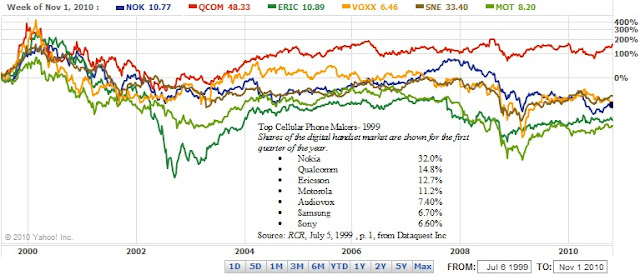In a graphic provided by the cost information website HowMuch.net, there is a eye opening review of crypto currencies compared to well known companies like Facebook,PayPal, and others.

On one side are companies providing services that seems to be increasing in demand. PayPal is an online payment system, Expedia is an online travel agency, Zillow is an online real estate resource, Brighthouse Financial is an insurance company, Groupon is an e-commerce marketing company. On the other side, there are five different crypto currencies.
There is no way that so many cryptocurrencies can exist, simply to do the same thing. There will have to be winners and losers. This reminds us about the market share of cell/smart phones and the change that occurred over time. In our November 7, 2010 article titled “Market Price and Market Share” we highlighted how much the cell phone market change from the the peak of the dot-com bubble to 2010. In that time, the top cell phone makers (now called “smart” phones) changed in unexpected ways.
| Top Mobile Phone Vendors 1999 |
| Vendor |
market share |
| Nokia |
32.00% |
| Qualcomm |
14.80% |
| Ericsson |
12.70% |
| Motorola |
11.20% |
| Audiovox |
7.40% |
| Samsung |
6.70% |
| Sony |
6.60% |
| source: RCR. July 5, 1999. Dataquest Inc. page 1. |
| Top Mobile Phone Vendors 2010 |
| Vendor |
3Q market share |
| Nokia |
32.40% |
| Samsung |
21.00% |
| LG Electronics |
8.30% |
| Apple |
4.10% |
| R.I.M. |
3.60% |
| Others |
30.50% |
| Total |
99.90% |
| Source: IDC Worldwide Quarterly Mobile Phone Tracker, October 28, 2010 |
What we always like to point out is that Nokia was the biggest by market share in 1999 and 2010 and yet it wasn’t the most innovative. Also, in 1999, Apple was nowhere to be found on the list of top five mobile phone vendors and yet it is among the top two today. Samsung has managed to stay among the top 6 in spite of not having the cache of Apple or (dare we say it) Rimm.
Which brings us back to the cryptocurrencies. Whoever is on top today is likely to not be a contender down the road. In fact, we believe that a yet-to-be-determined entrant will likely supplant Bitcoin as the “it” cryptocurrency. How are we going to find out the latest and greatest cryptocurrency? It will take a deflation and inflation cycle to get us there.
For now, keep in mind that there were hundreds of manufacturers of planes, trains, automobiles and mobiles phones before there were the big three. Deflation of the boom in cryptocurrencies will go a long way towards separating the wheat from the chaff.



